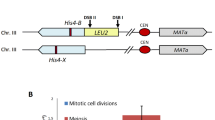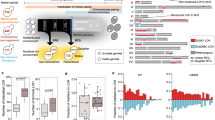Abstract
Random spore analysis of crosses between a strain bearing theade6-M26 hotspot mutation and strains bearing otherade6 mutations was performed. Recombinant prototroph frequencies increase with increasing distance fromM26 for mutations both 5′ and 3′ ofM26. Maximum prototroph frequencies are obtained for mutations lying more than 700 nucleotides down-stream fromM26. Similar results are obtained for crosses with theade6-M375 control mutation, but the prototroph frequencies are lower. The factor of stimulation of recombination byM26 as compared to theM375 control (M26 marker effect) also displays distance-dependence. These results are discussed in the context of the mechanism ofM26 recombination, as well as in relation to recombination initiation, hybrid DNA formation, and mismatch repair atade6.
Similar content being viewed by others
References
Alani E, Reenan RAG, Kolodner RD (1994) Interaction between mismatch repair and genetic recombination inSaccharomyces cerevisiae. Genetics 137:19–39
Bernardi F, Koller T, Thoma F (1991) Theade6 gene of the fission yeastSchizosaccharomyces pombe has the same chromatin structure in the chromosome and on plasmids. Yeast 7:547–558
Grigg GW (1958) Competitive suppression and the detection of mutations in microbial populations. Aust J Biol Sci 11:69–84
Grimm C, Kohli J, Murray J, Maundrell K (1988) Genetic engineering ofSchizosaccharomyces pombe: a system for gene disruption and replacement using theura4 gene as a selectable marker. Mol Gen Genet 215:81–86
Grimm C, Bähler J, Kohli J (1994)M26 recombinational hotspot and physical conversion tract analysis in theade6 gene ofSchizosaccharomyces pombe. Genetics 135:41–51
Gutz H (1971) Site-specific induction of gene conversion inSchizosaccharomyces pombe. Genetics 69:317–337
Gutz H, Heslot H, Leupold U, Loprieno N (1974)Schizosaccharomyces pombe. In: King RC (ed) Handbook of genetics, vol 1. Plenum Press, New York, pp 395–446
Heyer WD, Sipiczki M, Kohli J (1986) Replicating plasmids inSchizosaccharomyces pombe: improvement of symmetric segregation by a new genetic element. Mol Cell Biol 6:80–89
Munz P, Leupold U (1979) Gene conversion in nonsense suppressors ofSchizosaccharomyces pombe.I. The influence of the genetic background and of three mutant genes (rad2, mut1 andmut2) on the frequency of postmeiotic segregation. Mol Gen Genet 170:145–148
Nicolas A, Petes TD (1994) Polarity of meiotic gene conversion in fungi: contrasting views. Experientia 50:242–252
Ohta K, Shibata T, Nicolas A (1994) Changes in chromatin structure at recombination initiation sites during yeast meiosis. EMBO J 13:5754–5763
Orr-Weaver TL, Szostak JW (1985) Fungal recombination. Microbiol Rev 49:33–85
Ponticelli AS, Sena EP, Smith GR (1988) Genetic and physical analysis of the M26 recombination hotspot ofSchizosaccharomyces pombe. Genetics 114:347–361
Ponticelli AS, Smith GR (1992) Chromosomal context dependence of a cukaryotic recombination hotspot. Proc Natl Acad Sci USA 89:227–231
Rayssiguier C, Thaler DS, Radman M (1989) The barrier to recombination betweenEscherichia coli andSalmonella typhimurium is disrupted in mismatch-repair mutants. Nature 324: 396–401
Schär P, Kohli J (1993) Marker effects of G to C transversions on intragenic recombination and mismatch repair inSchizosaccharomyces pombe. Genetics 133:825–835
Schär P, Kohli J (1994) Preferential strand transfer and hybrid DNA formation at the recombination hotspotade6-M26 ofSchizosaccharomyces pombe. EMBO J 13:5212–5219
Schär P, Munz P, Kohli J (1993) Meiotic mismatch repair quantified on the basis of segregation patterns inSchizosaccharomyces pombe. Genetics 133:815–824
Schuchert P, Kohli J (1988) Theade6-M26 mutation ofSchizosaccharomyces pombe increases the frequency of crossing over. Genetics 119:507–515
Schuchert P, Langsford M, Käslin E, Kohli J (1991) A specific DNA sequence is required for high frequency of recombination in theade6 gene of fission yeast. EMBO J 10:2157–2163
Smith GR (1994) Hotspots of homologous recombination. Experientia 50:234–242
Szankasi P, Heyer WD, Schuchert P, Kohli J (1988) DNA sequence analysis of theade6 gene ofSchizosaccharomyces pombe. Wild-type and mutant alleles including the recombination hot spotede6-M26. J Mol Biol 204:917–925
Virgin JB, Metzger J, Smith GR (1995) Active and inactive transplacement of theM26 recombination hotspot, inSchizosaccharomyces pombe. Genetics 141:33–48
Wahls WP, Smith GR (1993) TheM26 homologous recombination hotspot: sequences, factors and chromosomal context. In: Summer AT, Chandley AC (eds) Chromosomes today, vol. 11. Chapman and Hall, London, UK, pp 351–363
Wahls WP, Smith GR (1994) A heteromeric protein that binds to a meiotic homologous recombination hot spot: correlation of binding and hotspot activity. Genes Dev 8:1693–1702
Wu TC, Lichten M (1994) Meiosis-induced double-strand break sites determined by yeast chromatin structure. Science 263:515–518
Zahn-Zabal M, Lehmann L, Kohli J (1995) Hotspots of recombination in fission yeast: inactivation of theM26 hotspot by deletion of theade6 promoter, and the novel hotspotura4-aim. Genetics 140:469–478
Author information
Authors and Affiliations
Additional information
Communicated by K. Wolf
Rights and permissions
About this article
Cite this article
Zahn-Zabal, M., Kohli, J. The distance-dependence of the fission yeastade6-M26 marker effect in two-factor crosses. Curr Genet 29, 530–536 (1996). https://doi.org/10.1007/BF02426957
Received:
Issue Date:
DOI: https://doi.org/10.1007/BF02426957




